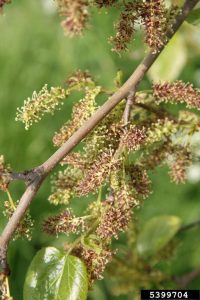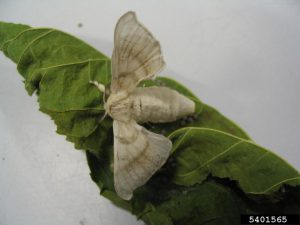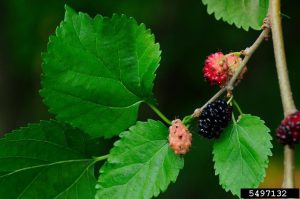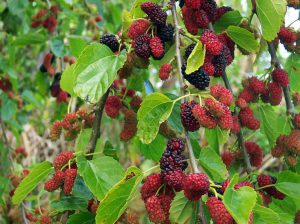The mulberry (Morus spp.) is a fruiting tree rich in flavor, with nutritious foliage, a myriad of medicinal and culinary value, and a fascinating history. With numerous species, hybrids, and endless cultivars to choose from—a mulberry may be the perfect fit for your Florida-friendly landscape.
In addition to jackfruit, breadfruit, and figs, mulberries belong to the family Moraceae, which contains approximately 40 genera and 1,000 species. While there is much debate on exactly how many taxa belong to the genus Morus, there are approximately 64 species currently acknowledged, the majority of which occur in Asia. There are three species of mulberry most commonly cultivated here in the United States: the red mulberry (Morus rubra), the white mulberry (Morus alba), and the black mulberry (Morus nigra), along with a handful of hybrid cultivars. The fruit of mulberries can range in color from white to pink, purple or black, depending on the species, variety or cultivar selected. In fact, the names of white, red, and black mulberries are derived from the color of the floral bud that forms, not necessarily the color of the fruit produced.

Mulberries are deciduous trees, losing their leaves seasonally, although they can behave as an evergreen in tropical or subtropical climates. Individual trees are either monoecious (containing both male and female flowers) or dioecious (male and female flowers on separate plants). Whether dioecious or monecious, catkin flowers produced are single-sexed. Pollen produced by single-sex catkins is extremely light weight, aiding in high-speed wind pollination. This is incredibly important, as mulberries do not rely on animal-mediated pollination for fruit set. In fact, it has been noted that the pollen release mechanism for some mulberry species can travel at half the speed of sound (350 mph)!
White mulberries (Morus alba) Native to Central and Eastern China, the white mulberry has an extremely rich cultural history. With an expansive distribution range, it was treasured by Persians, Romans, and Greeks for a variety of purposes. The primary purpose—sericulture! Sericulture is the practice of rearing silkworms for silk production. Silkworms are not actually true worms, but instead the caterpillar, or larval life stage, of a very impressive moth species, Bombyx mori. Adult female moths will first lay an egg on the surface of a white mulberry leaf. After hatching into the larval form, it will feed exclusively on the foliage of white mulberries. Silkworm feeding is so voracious, it is estimated that a single caterpillar will consume nearly 30,000 times its weight! Eventually satiated, these caterpillars will then begin spinning a cocoon made entirely of silk as they transition into their pupal stage. A single pound of silk is said to require 3,000 cocoons. Silk worms are not the only animals with a taste for mulberries leaves. Many ruminants, pigs, and even humans regularly consume mulberry leaves as they are rich in protein, antioxidants, vitamin C, zinc, calcium, iron, potassium, and magnesium. In the wild, pupae will eventually hatch into their adult moth form, continuing on their life cycle. However, silk worm pupae are routinely consumed as a culinary dish in many parts of Asia and around the world.

Originally introduced to the United States in hopes of establishing a successful silk industry, the white mulberry is now noted as somewhat of a nuisance species. While it is not currently listed as an invasive plant in Florida, other states such as Pennsylvania, West Virginia, Virginia, Maryland, Ohio, Michigan, Georgia, and South Carolina have included this species on their invasive plant lists. White mulberry is a fast grower that is capable of invading forest edges and disturbed sites, but has not yet been recorded outcompeting native species for resources such as light, water, space, and nutrients. Of special concern is the ease with which the white mulberry will hybridize with our native red mulberry species.
Red Mulberry (Morus rubra) The red mulberry is native to Eastern and Central North America and can commonly be found growing in mesic hardwood forests, floodplains, and other moisture-rich sites everywhere from south Florida, across Texas, and as far north as Ontario, Canada. A relatively fast-growing species, this species can reach heights between 15 and 70 feet, depending on site conditions. Similar to other Morus species, the leaves are variable in shape, producing both heart-shaped and lobed foliage. Pollen from male flowers is extremely allergenic, so be mindful of this if cultivating red mulberries in your landscape!

The first documented use of red mulberry comes from De Soto in the mid-1500s, who noted it’s consumption by the Muskogee Native Americans. The Iroquois mashed, dried, and preserved mulberries to later add to water to make sauces. The Timucua of northeast Florida utilized the leaves, twigs, and berries to make dyes, and the Seminoles made use of the branches for their bows. Furthermore, there is no shortage of medicinal value to the red mulberry! The Alabama and Creek peoples utilized extracts from the roots to treat urinary tract infections, while the Rappahannock used the milky sap as a topical treatment for ringworm. Lastly, the Cherokee would create a tea from the bark to combat intestinal worms. For those interested in acquiring our native red mulberry tree, be sure to check out the Florida Association of Native Nurseries search tool to determine availability in your area.
Black Mulberry (Morus nigra) Many folks consider the fruit of the black mulberry to be of the highest quality. Native to Southwestern Asia and the Middle East, the black mulberry is extremely popular in dry, warmer areas with Mediterranean climates. Here in Florida, black mulberry trees may take on a shorter, more bush-like growth habit. The fruit produced is sweet, tart, and dark purple/black in color. This rich, pigmented color is largely owed to the presence of anthocyanins, which have antioxidant properties and help to protect our bodies from free radicals.

Paper Mulberry (Broussonetia papyrifera). Worth mention is the paper mulberry. While paper mulberry belongs to the same family as our beloved red, black, and white mulberries, it is not in the genus Morus. Paper mulberry is an extremely aggressive species that rapidly takes over many sites throughout Florida. Paper mulberry has been classified as a Category II invasive species here in Florida. This means that is has been proven to invade and displace native plant communities. More information on the paper mulberry can be found here.
 10
10
